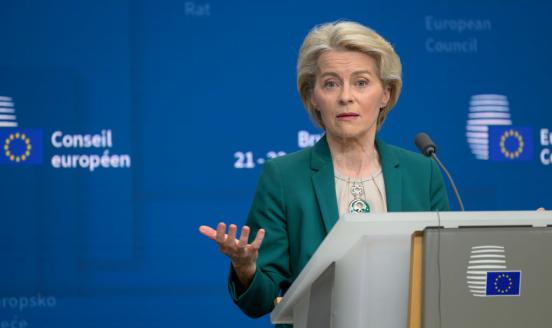Next Generation EU payments across countries and years
How much cake does everyone actually get and at what speed?

The Special European Council of July 2020 defined the total amount of Next Generation EU (NGEU) commitments at 2018 prices. Existing estimates, including my earlier ones, allocated these 2018 price amounts across countries, or reported the yearly breakdown of the total, but did not include the yearly breakdown per country in current prices in euros. This blogpost fills this gap by estimating the euro amounts of NGEU payments to each EU country in each year between 2021 and 2026. I also report these payment estimates as a share of yearly gross national income (GNI).
Payments will be made in current prices in euros (or for simplicity actual euros) not in a hypothetical 2018 prices in euros. The 2018 price amounts are hypothetical because in EU budgetary practice, a 2% annual rate of inflation is used to translate 2018 prices in euros to actual prices in euros, irrespective of actual inflation. For example, using this 2% annual inflation conversion, 100 euros at 2018 prices is equivalent to 106 actual euros in 2021 and 117 actual euros in 2026, which are the first and last year respectively when NGEU payments will be made.
In my calculations, I find that for the EU as a whole the amount of €390 billion in 2018 prices decided by the European Council for grants and guarantees will lead to €420 billion in actual euro payments. This also implies that EU borrowing will amount to €420 billion and not the 2018 price value of €390 billion (provided that all payments will be made which we cannot take for granted, see here).
In addition to the aggregate of grants and guarantees, I report calculations for NGEU loans. We do not know which countries will apply for loans: I assume that those 17 countries that borrowed from the EU’s employment-support loan facility SURE (temporary Support to mitigate Unemployment Risks in an Emergency) will also borrow from NGEU. I also assume that these countries will borrow the maximum available amount, 6.8% of GNI.
This blogpost also updates my earlier calculations for the total (at 2018 prices) cross-country allocations, resolving an important ambiguity in the European Council conclusions thanks to a recent Commission estimate (see the details at the end of this post).
Let me first present the results in the four tables below and then discuss the assumptions I made for the estimations.
Estimating the current euro value payments from NGEU grants and guarantees corresponding to the July 2020 European Council conclusions
The European Council set an amount of €390 billion at 2018 prices for grants (which also includes some guarantees). In order to calculate how much each country is expected to get from NGEU in each year, estimating the difference between amounts measured at 2018 prices and at current euro values requires a careful consideration for the following reasons:
- There is a difference between commitments (a promise to pay) and payments (money actually disbursed) in the EU budget (see an explanation of this differentiation here);
- The European Council specified the total amounts of NGEU commitments at 2018 prices;
- The sum of yearly commitments measured at 2018 prices over the 2021-2023 period must be equal to the total amount set by the European Council;
- The EU budget includes actual euro amounts for both commitments and payments: the total euro amount of commitments made in 2021-2023 must be equal the total euro amount of payments in 2021-2026;
- In EU budgeting practice, as mentioned above, the 2018 price values are converted to actual euro values by assuming a 2% annual inflation rate, irrespective of the actual inflation rate;
- As such the time profile of commitments at 2018 prices has an impact on the actual euro amounts;
- Another implication is that since, as mentioned above, the actual euro amount of commitments over 2021-2023 equals the actual euro amount of payments in 2021-2026, the sum of 2018 price commitments over the 2021-2023 period will not be equal to the sum of 2018 price payments over 2021-2026;
- While the May 2020 Commission proposal was complete, including the yearly breakdown of the actual euro amounts of commitments and payments (from which one can calculate the 2018 price amount of commitments to confirm that the sum of annual amounts is equal to the 2018 price total amount), the European Council conclusions did not break down the annual values;
- The European Council changed the total amounts measured at 2018 prices relative to the Commission proposal and brought the cut-off dates closer, requiring that all NGEU commitments be made by the end of 2023 and NGEU payments be completed by the end of 2026.
Thus, the annual breakdown of actual euro amounts corresponding to the European Council conclusions cannot be easily calculated by just multiplying the actual amounts from the initial Commission proposal by the ratio of the Council totals to the Commission totals because the timeframe has changed, modifying the yearly distribution of 2018 price annual figures, which impacts the actual euro figures.
My calculations address these issues in five steps.
- First, I adjust the initial Commission proposal to the new timeframe by assuming that the commitments (measured at 2018 prices) planned by the Commission after 2023, will be made in 2023.
- Second, I multiple these 2018 price value amounts with the ratio of Council totals by the Commission totals to get the new time-profile of commitments at 2018 prices corresponding to the European Council conclusions.
- Third, I calculate the corresponding actual euro value of commitments. The sum of the actual euro value of yearly commitments will have to be equal to sum of the actual euro value of yearly payments, hence I derived total euro payments in actual euros.
- Fourth, I adjust the time profile of the Commission’s initial proposal for actual euro payments with the assumption that all payments that were planned by the Commission to be made after 2026 will be made in 2026.
- Fifth, the newly calculated total euro amounts of payments are distributed over 2021-2026 according to the time profile of the adjusted initial Commission time profile for euro value payments.
These calculations were completed for each of the seven components of NGEU grants and guarantees (RRF, ReactEU, Just Transition Fund, EAFRD, rescEU, Horizon Europe, InvestEU), because each component has a different time profile of payments.
Finally, one more adjustment is made: the European Council concluded that there will be a 10% pre-financing for the Recovery and Resilience Facility (RRF) in 2021, but it did not specify whether the 10% relates to 2018 price or current price values. I assume it relates to current price values. Thus, I alter the expected 2021 and 2022 RRF payments so that 10% of the total 2021-2026 payments will be made in 2021 and reduce the 2022 payments correspondingly, so that the sum of 2021 and 2022 payments (measured in current price euros) remains the same.
The calculations described so far relate to the EU as a whole. In order to estimate country-specific yearly values, I assume that the % distribution across the years is the same for each country (but separately, of course, for each of the seven components of NGEU). Thus, for each component of NGEU, I estimate the current euro value of payments for each country, and then for each country, I add up the euro value estimates for the seven components to obtain the country-specific yearly payments from NGEU in actual euros.
Estimating the current euro value payments from NGEU loans corresponding to the July 2020 European Council conclusions
The estimation of yearly loan pay-outs from NGEU is much simpler, because the Commission in its initial proposal planned to make all commitments in 2021-2022 and all payments in 2021-2025, hence it is not impacted by the European Council’s new deadline of 2023 for commitments and 2026 for payments.
However, the Commission’s initial proposal planned a total amount of €250 billion of loans (at 2018 prices) to be committed by €125 billion in 2021 and 2022 each. The European Council increased the ceiling of loans to €360 billion (again at 2018 prices), but did not indicate a time-frame for commitments and payments. I assume that €120 billion (at 2018 prices) will be committed in each year in 2021-2023 and calculate the corresponding euro value of commitments. Then I distribute this total current price euro value pay-outs proportionally to the yearly distribution of the euro-value of pay-outs of the Commission’s initial proposal, which covers only the five-year period of 2021-2025.
There are two uncertainties related to NGEU loans.
First, while the European Council set the ceiling of loans at 6.8% of GNI each country, neither the European Council, nor the May 2020 proposal of the Commission, have specified the year(s) of the GNI to be considered. I assume it is the 2020 GNI measured at current prices.
Second, we do not know which countries will apply for loans and whether they will get the full potential amount of 6.8% of GNI. For illustrative purposes, I assume that the same 17 countries that borrowed from the EU’s employment-support loan facility called SURE (the temporary Support to mitigate Unemployment Risks in an Emergency) will also borrow from the NGEU, and that they will take all the loans amounting to 6.8% of their GNI each.
GNI forecasts
I also report the NGEU payments as the share of GNI. Currently, the November 2020 Commission estimates are available for GNI up to 2022, while the October 2020 IMF World Economic Outlook includes GDP forecasts for 2020-2025 (but no GNI data is available in the WEO). I use the Commission GNI forecast up to 2022 and I assume that GNI growth in 2023-2025 will be the same as the IMF forecast GDP growth for these years. For 2026, I assume a growth rate similar to 2025.
Revising my earlier estimates for the total cross-country allocations at 2018 prices
The estimation of the expected country-allocation of gross pay-outs from the Commission’s initial May 2020 proposal for Next Generation EU (NGEU) was straightforward. The Commission itself published the results of its calculation for the Recovery and Resilience Facility (RRF) and the Just Transition Fund, while for the increased agricultural subsidies the allocation follows a 2018 proposal and hence is also known. Thus, for 71% of NGEU grants and guarantees, the cross-country allocation was known. Estimation of the country allocation of the Recovery Assistance for Cohesion and the Territories of Europe (ReactEU) can be done on the basis of the annex of the regulation proposal, which lists the mathematical formula and the various adjustments to it, even though estimation has to be based on forecasted GDP and unemployment developments. ReactEU accounted for an additional 10% of NGEU funds. The remaining facilities of NGEU accounted for 19% of total NGEU funds, not a decisively large amount, for which assumptions had to be made to estimate a cross-country distribution. Altogether, the uncertainty of the overall cross-country allocation estimate of NGEU was modest.
However, the July 2020 European Council brought ambiguity, because it replaced the “unemployment criterion” with the “loss in real GDP” for 30% of RRF allocation, but did not specify how to measure it (see point 16 here). The same expression, “loss in real GDP”, is used for ReactEU by the Commission referring to the “share of each Member State of the total loss of real seasonally adjusted GDP expressed in EUR between the first semester of 2019 and the end of the applicable reference period for all Member States considered”. Thus, the natural conclusion was that the loss in real GDP means the same for ReactEU and RFF and I used this assumption to estimate the new allocation of the RFF.
In September 2020, the Commission published new estimates for the RRF allocation corresponding to the July 2020 European Council conclusions, which apparently uses a different interpretation of the “loss in real GDP”. The Commission did not provide any explanation of the estimation methodology, nor any hint why the “loss in real GDP” means different things for RRF and ReactEU. It’s a pity that the EU’s landmark recovery facility suffers from issues of transparency.
Using these Commission estimates for RFF, I updated my estimates for the overall cross-country allocation of grant and guarantee payments from NGEU commitments at 2018 prices. Then, I used the methodology described above to estimate the payments in actual euros and as a share of GNI in each year in 2021-2026 for each EU country.
Additionally, I have updated the expected cross-country allocation of ReactEU using most the recent quarterly GDP and unemployment data as well as the November 2020 forecast of the European Commission. See the methodology of these estimates here.
Compared to the Commission’s May 2020 proposal, the overall allocation of grants was reduced by 11% by the European Council. France is not expected to suffer a reduction, while the reduction is expected to be much smaller than the average reduction in Czechia, Luxembourg , Malta, Portugal and Italy. On the contrary, a much larger than average reduction is expected for Denmark, Estonia, Poland, Finland, Slovenia and Bulgaria.
Recommended citation:
Darvas, Z. (2020) ‘Next Generation EU payments across countries and years’ Bruegel Blog, 12 November



